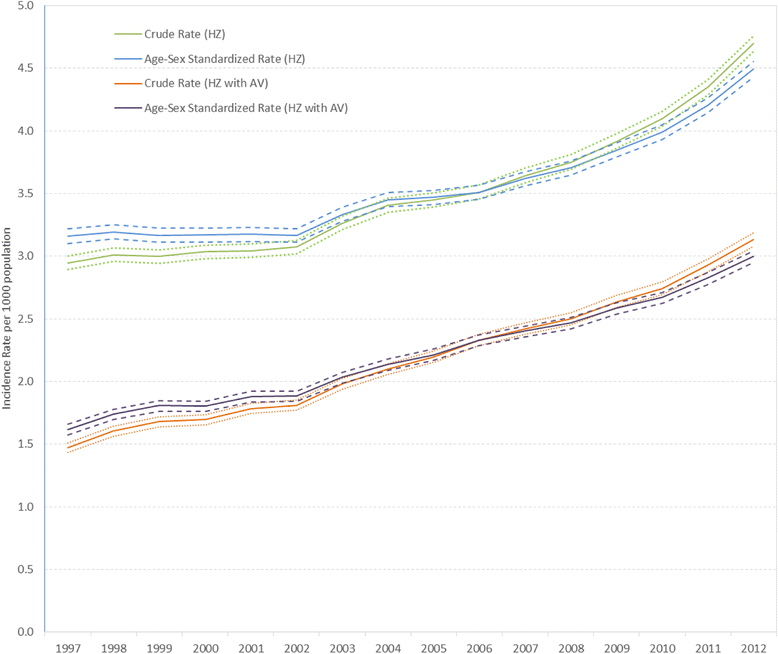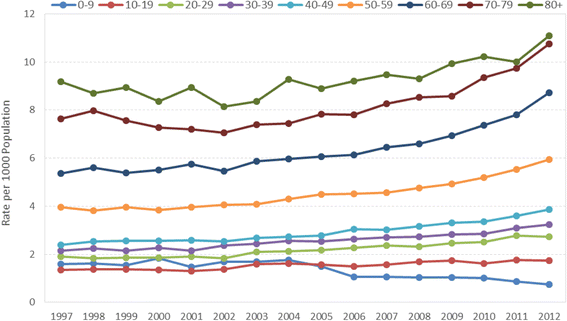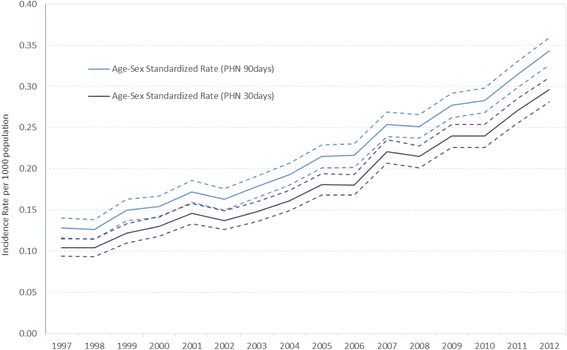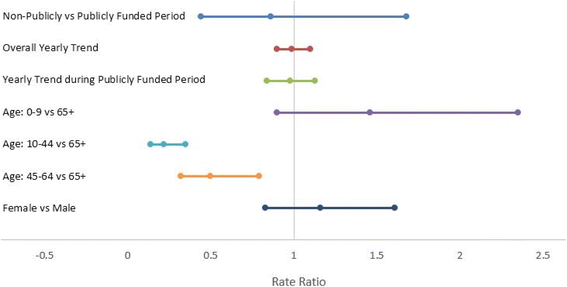Increasing incidence associated with herpes zoster infection in British Columbia, Canada
- PMID: 27765026
- PMCID: PMC5073843
- DOI: 10.1186/s12879-016-1898-z
Increasing incidence associated with herpes zoster infection in British Columbia, Canada
Abstract
Background: Recent studies have shown an increasing incidence of herpes zoster (HZ) infection, which may be related to the introduction of varicella vaccination programs in children. We examined the epidemiology and treatment costs of HZ and post-herpetic neuralgia (PHN) over time in British Columbia, Canada.
Methods: The cohort consisted of all cases with HZ infection from January 1, 1997 and December 31, 2012. Incident zoster was defined as a case (ICD-9 053 or ICD-10 B02) without a previous episode of HZ or PHN in the previous 12 months. We determined the incidence for HZ and PHN and the age-sex standardized rate for the overall population. We determined the association between the varicella vaccination program and increased HZ rates by evaluating the rate ratios in the publicly-funded varicella vaccine period compared to the non-publicly funded period in a regression model. We evaluated the hospitalization rates, treatment by GPs and their associated yearly costs for HZ and PHN.
Results: HZ incidence increased for the entire study period from 3.2 per 1000 population in 1997 to 4.5 in 2012. HZ rates were higher for females than males and all age groups had an increased incidence rate, except the 0-9 year olds, where the rate decreased. Crude and age-sex standardized incidence rates of PHN demonstrated very similar patterns to HZ incidence. Based on the regression model, rates of HZ were higher in the older individuals. No significant increase with HZ incidence was seen during the publically funded varicella vaccination program compared to the non-publicly funded period. From 1997 to 2012, the annual HZ-related costs associated with hospitalizations and GP visits were over $CDN4.9 million and $CDN537,286, respectively; treatment costs for hospitalizations have increased significantly over time. Majority of PHN-related cases are managed by GPs, with a steady increase over time in number of cases and associated annual costs.
Conclusions: The incidence of zoster and PHN is increasing with time, particularly in the elderly population and the risk is greater in the over 65 year olds. Treatment costs for both HZ and PHN represent a significant burden on the Canadian healthcare system.
Keywords: Epidemiology; Herpes zoster; Incidence; Post-herpetic neuralgia.
Figures





References
-
- Miller E, Marshall R, Vurdien J. Epidemiology, outcome and control of varicella-zoster infection. Rev Med Microbiol. 1993;4(4):222e30. doi: 10.1097/00013542-199310000-00006. - DOI
MeSH terms
Substances
LinkOut - more resources
Full Text Sources
Other Literature Sources
Medical

